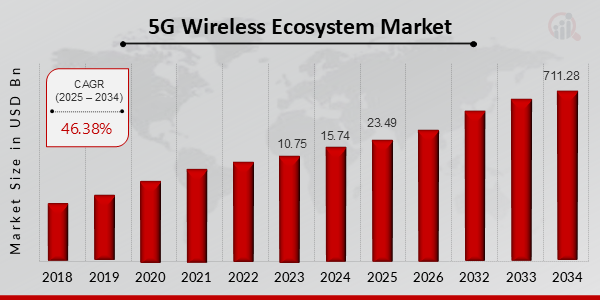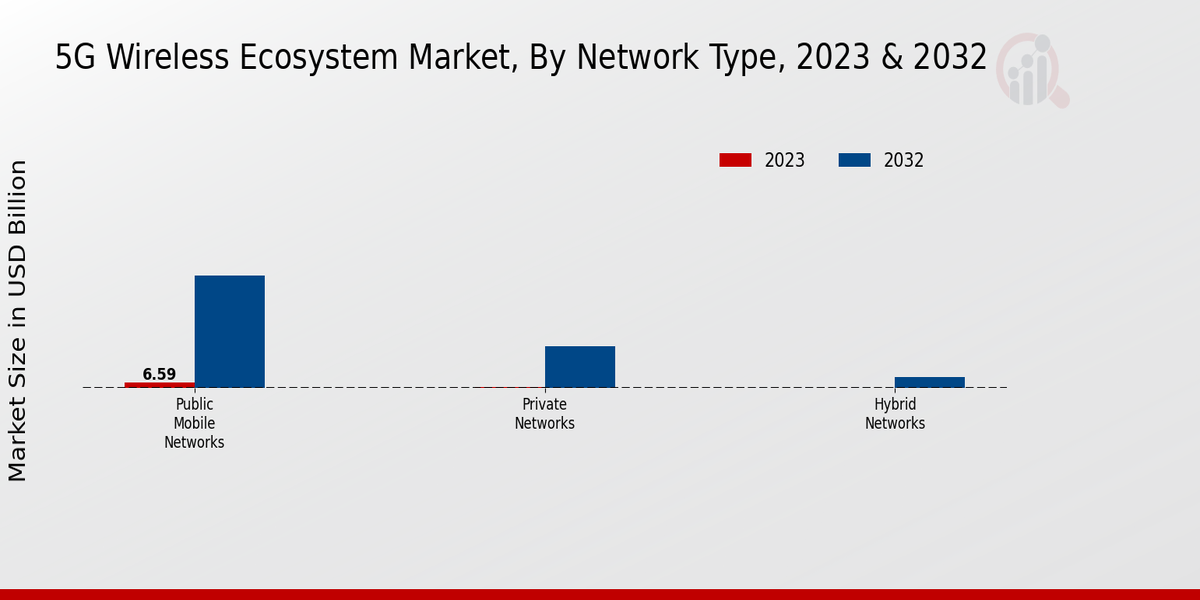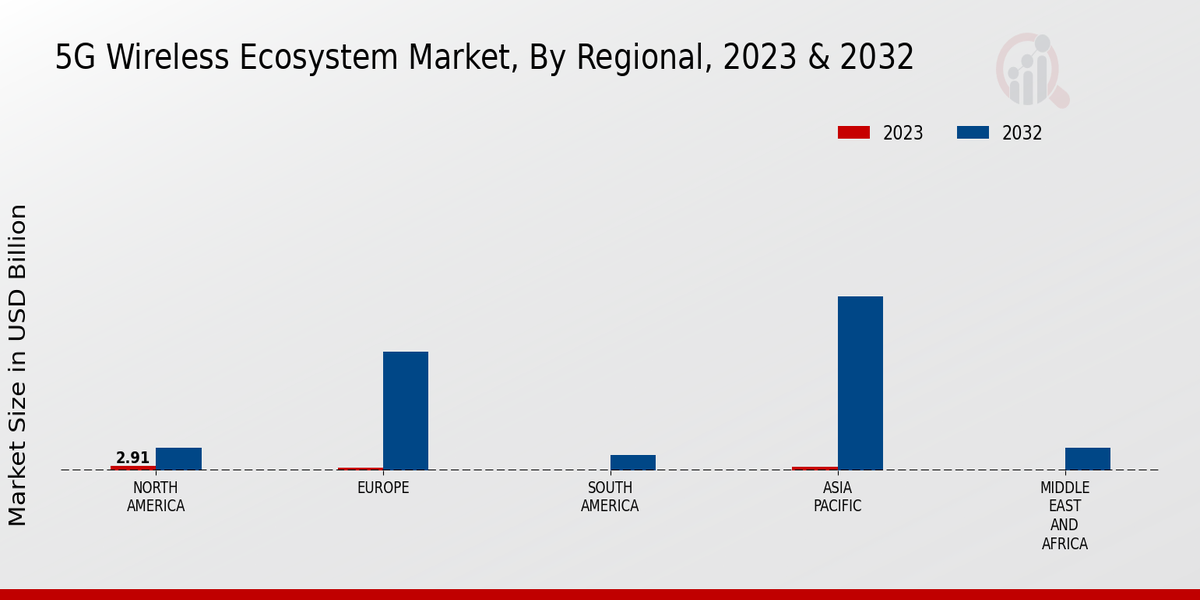5G Wireless Ecosystem Market Overview
5G Wireless Ecosystem Market is projected to grow from USD 23.49 Billion in 2025 to USD 711.28 Billion by 2034, exhibiting a compound annual growth rate (CAGR) of 46.38% during the forecast period (2025 - 2034). Additionally, the market size for 5G Wireless Ecosystem Market was valued at USD 15.74 billion in 2024.
Key 5G Wireless Ecosystem Market Trends Highlighted
The 5G wireless ecosystem market is growing fast because of the need for quick connections and advancement in technology. The demand for cloud services, increased mobile phone adoption and the introduction of 5G networks are some of the factors that will drive the growth in this industry. Opportunities can be found at first in 5G technology’s new applications like edge computing, cloud gaming as well as autonomous vehicles. By including artificial intelligence (AI) and machine learning (ML) in 5G networks, it creates room for growth opportunities by enhancing network management and optimization. A recent development in the 5G wireless ecosystem market has been virtual reality (VR)/augmented reality (AR), which requires a lot of bandwidth with low latency. Furthermore, it’s connecting up with other emerging technology trends, such as the Internet of Things (IoT), that would increase market potential by enabling new smart cities and industrial applications. Thus, companies must identify these trends and drivers to succeed in the changing world of the 5G wireless ecosystem market.
Figure 1: 5G Wireless Ecosystem Market, 2025 - 2034

Source: Primary Research, Secondary Research, MRFR Database and Analyst Review
5G Wireless Ecosystem Market Drivers
Rising Demand for Enhanced Mobile Broadband Services
The 5G Wireless Ecosystem Market Industry is driven by the growing demand for high-speed and low-latency mobile broadband services. 5G technology enables significantly faster speeds and lower latency than previous generations of wireless technology, thus allowing a wide range of new applications and services, such as mobile gaming, virtual reality and augmented reality, and self-driving cars. As the demand for these services continues to increase, the demand for 5G-enabled devices and infrastructure will also grow.
Government Support and Investment
Governments around the world are recognizing the importance of 5G technology and are investing heavily in its development and deployment. This support is coming in the form of funding for research and development, subsidies for 5G-enabled devices, and the allocation of spectrum for 5G use. Government support is playing a critical role in accelerating the adoption of 5G technology and is expected to continue to be a major driver of the 5G Wireless Ecosystem Market Industry in the coming years.
Advancements in Semiconductor Technology
Another significant Market Industry Driver of the 5G Wireless Ecosystem Market Industry is the development of new semiconductor technologies. 5G technology requires advanced semiconductors that can support the high speeds and low latency of 5G networks. Developing these semiconductors is a complex and expensive process, but it is essential for the continued growth of the 5G ecosystem. As semiconductor technology continues to advance, the cost of 5G-enabled devices and infrastructure will be reduced, making them accessible to a broader range of consumers and businesses.
5G Wireless Ecosystem Market Segment Insights
5G Wireless Ecosystem Market Network Type Insights
The market is segmented into three based on the type of networks to be deployed; that is, Public Mobile Networks, Private Networks, and Hybrid Networks. Public Mobile Networks are the most common type of 5G network used by mobile operators to provide consumers and businesses with wireless broadband services. Private Networks are used by businesses, enterprises, and other organizations to create private wireless networks tailor-made to their requirements. This may include private networks specifically designed for industrial automation or campus-wide networking to create a wireless local area network.
A Hybrid Network is a combination of both Public Mobile Networks and Private Networks. The driving factors of the market include the increasing demand for an efficient, high-speed, and reliable wireless broadband network, the increase in IT gadgets integrated with IoT Technology, and the growing adoption of 5G Network Technology by businesses and enterprises. The Public Mobile Networks are expected to account for over 60% of the 5G Wireless Ecosystem Market revenue in 2023; as the demand for mobile broadband services increases, the usage and adoption of 5G smartphones grow, as well as the expansion of 5G Networks.
Public Mobile Networks are also expected to grow, albeit at a slower CAGR pace than Private Networks. Private Networks are also expected to grow, driven by the increase in demand for secure and reliable wireless broadband connectivity by businesses and organizations. Hybrid Networks are expected to account for a fraction of a percent of the 5G Wireless Ecosystem Market revenue in 2023 but grow, with a CAGR of 55.94% from the years 2023 to 2032. The growth is attributed to the driver of a rapidly increasing number of businesses and other types of organizations looking for a flexible and more customizable network.
Figure2: 5G Wireless Ecosystem Market, By Condition, 2023 & 2032

Source: Primary Research, Secondary Research, MRFR Database and Analyst Review
5G Wireless Ecosystem Market Frequency Bands Insights
The 5G Wireless Ecosystem Market is segmented based on frequency bands into low-band (below 1 GHz), mid-band (1-6 GHz), high-band (above 6 GHz), and millimeter-wave (above 24 GHz). Among these, the low-band segment accounted for the largest revenue share in 2023. The mid-band segment is projected to grow at the highest CAGR during the forecast period, owing to its wide range of applications. The high-band segment is expected to witness significant growth due to its ability to provide high-speed and low-latency connectivity. The millimeter-wave segment is still in its early stages of development but has the potential to revolutionize wireless communications in the future.
5G Wireless Ecosystem Market Services Insights
The Services segment is anticipated to garner a significant share of the 5G Wireless Ecosystem Market revenue throughout the forecast period. This growth can be attributed to the increasing adoption of 5G technology across various industries. Services such as Enhanced Mobile Broadband (eMBB), Ultra-Reliable Low-Latency Communication (URLLC), and Massive Machine-Type Communication (mMTC) are expected to drive the growth of this segment. eMBB enables high-speed data transmission, making it suitable for applications such as streaming videos, gaming, and downloading large files.URLLC provides reliable and low-latency communication, which is crucial for applications such as autonomous vehicles and remote surgeries. mMTC allows for the connection of a massive number of devices, making it ideal for applications such as smart cities and industrial automation. The 5G Wireless Ecosystem Market data shows that these services are expected to witness substantial growth in the coming years, contributing to the overall expansion of the market.
5G Wireless Ecosystem Market Deployment Models Insights
The 5G Wireless Ecosystem Market is segmented by deployment models into Independent Networks, Non-Stand Alone (NSA) Networks, and Standalone (SA) Networks. The Independent Networks segment is expected to account for the largest revenue share in 2024, owing to the increasing adoption of private 5G networks by enterprises. The NSA Networks segment is expected to witness significant growth, driven by the early deployment of 5G services using NSA technology. The SA Networks segment is expected to gain traction in the later stages of the forecast period as operators transition to fully standalone 5G networks.
5G Wireless Ecosystem Market End-Use Industries Insights
The 5G Wireless Ecosystem Market segmentation by End-Use Industries provides insights into the adoption and application of 5G technology across various industries. Telecommunications, manufacturing, healthcare, transportation, and utilities are key end-use industries driving the market growth. The telecommunications industry, with its focus on enhancing network infrastructure and connectivity, is expected to contribute significantly to the market revenue. The manufacturing sector is leveraging 5G for automation, robotics, and predictive maintenance, leading to increased efficiency and productivity.
In healthcare, 5G enables remote patient monitoring, telemedicine, and advanced surgical procedures, transforming healthcare delivery. The transportation industry utilizes 5G for connected vehicles, fleet management, and autonomous driving, improving safety and efficiency. Utilities leverage 5G for smart grid management, remote monitoring, and demand-side management, optimizing energy distribution and consumption. These industries' growing adoption of 5G solutions is propelling the overall market growth, with analysts projecting the 5G Wireless Ecosystem Market to reach a substantial valuation in the coming years.
5G Wireless Ecosystem Market Regional Insights
The regional segmentation of the 5G Wireless Ecosystem Market presents a diverse landscape with varying growth patterns and opportunities. North America leads the market with a significant share, driven by the presence of major telecom operators and advanced network infrastructure. The region is expected to maintain its dominance in the coming years, with a projected market revenue of USD 23.24 billion by 2024. Europe follows closely behind North America, with a growing demand for 5G services in countries like Germany, the United Kingdom, and France.
The region is expected to reach a market value of USD 14.83 billion by 2024, supported by government initiatives and investments in 5G infrastructure. APAC is a rapidly growing region for the 5G Wireless Ecosystem Market, with countries like China, India, and Japan emerging as key markets. The region is expected to witness substantial growth in the coming years, with a projected market revenue of USD 17.62 billion by 2024. This growth is attributed to increasing smartphone penetration, rising consumer demand for high-speed internet, and government support for 5G adoption. South America and MEA are emerging markets for the 5G Wireless Ecosystem Market, with significant growth potential. These regions are expected to experience increasing investments in 5G infrastructure and services, driven by the growing demand for mobile connectivity and the expansion of digital economies.
Figure 3: 5G Wireless Ecosystem Market, By Regional, 2023 & 2033

Source: Primary Research, Secondary Research, MRFR Database and Analyst Review
5G Wireless Ecosystem Market Key Players And Competitive Insights
Major players in the 5G Wireless Ecosystem Market are focusing on developing innovative products and solutions to cater to the evolving needs of customers. They are also investing heavily in research and development to stay ahead of the competition. The 5G Wireless Ecosystem Market industry is characterized by intense competition, with leading 5G Wireless Ecosystem Market players adopting various strategies to gain market share. Leading players in the 5G Wireless Ecosystem Market are focusing on expanding their geographical presence and forming strategic partnerships to strengthen their market position. The 5G Wireless Ecosystem Market is expected to witness significant growth in the coming years, driven by factors such as increasing demand for high-speed internet connectivity, growing adoption of smart devices, and advancements in 5G technology.
Among the leading players in the 5G Wireless Ecosystem Market, Qualcomm stands out as a major player. The company is known for its innovative semiconductor solutions and has a strong presence in the 5G market. Qualcomm has been actively involved in the development and deployment of 5G technology and has played a key role in shaping the 5G ecosystem. The company's 5G chipsets and other products are widely used by smartphone manufacturers and other device makers. Qualcomm is also actively involved in research and development to drive the advancements of 5G technology.
Another major player in the 5G Wireless Ecosystem Market is Nokia. The company is a leading provider of telecommunications infrastructure and services and has a strong focus on 5G technology. Nokia has been actively involved in the development and deployment of 5G networks worldwide and has partnered with several major mobile operators to provide 5G services. The company's 5G solutions include base stations, core network elements, and software. Nokia is also investing heavily in research and development to drive the advancements of 5G technology.
Key Companies in the 5G Wireless Ecosystem Market Include
5G Wireless Ecosystem Market Industry Developments
The 5G Wireless Ecosystem Market is poised to experience exponential growth in the coming years, driven by increasing demand for high-speed connectivity, low latency, and enhanced mobile broadband services. In 2023, the market is valued at USD 18.4 billion and is projected to reach USD 226.6 billion by 2032, exhibiting a CAGR of 46.38%. Key factors fueling this growth include rising investments in 5G infrastructure, the proliferation of Internet of Things (IoT) devices, and the adoption of cloud and edge computing technologies. Recent developments in the market include the launch of standalone 5G networks, the commercialization of millimeter-wave spectrum, and the emergence of Open RAN (Radio Access Network) solutions. These advancements are expected to further accelerate the adoption of 5G technology and drive market expansion.
5G Wireless Ecosystem Market Segmentation Insights
-
5G Wireless Ecosystem Market Network Type Outlook
-
5G Wireless Ecosystem Market Frequency Bands Outlook
-
5G Wireless Ecosystem Market Services Outlook
-
5G Wireless Ecosystem Market Deployment Models Outlook
-
5G Wireless Ecosystem Market End-Use Industries Outlook
-
5G Wireless Ecosystem Market Regional Outlook
|
Report Attribute/Metric
|
Details
|
|
Market Size 2024
|
15.74 (USD Billion)
|
|
Market Size 2025
|
23.49 (USD Billion)
|
|
Market Size 2034
|
711.28 (USD Billion)
|
|
Compound Annual Growth Rate (CAGR)
|
46.38% (2025 - 2034)
|
|
Report Coverage
|
Revenue Forecast, Competitive Landscape, Growth Factors, and Trends
|
|
Base Year
|
2024
|
|
Market Forecast Period
|
2025 - 2034
|
|
Historical Data
|
2019 - 2023
|
|
Market Forecast Units
|
USD Billion
|
| Key Companies Profiled |
Nokia, Altiostar, Cisco, ZTE, Affirmed Networks, Ericsson, NEC, Samsung, Intel, Huawei, Fujitsu, Parallel Wireless, Mavenir, Qualcomm |
| Segments Covered |
Network Type, Frequency Bands, Services, Deployment Models, End-Use Industries, Regional |
| Key Market Opportunities |
Increased mobile data trafficGrowth of IoT and connected devicesRise of cloud and edge computing5G network infrastructure expansionEnterprise adoption of 5G technology |
| Key Market Dynamics |
Increasing demand for highspeed internetGovernment initiatives to promote 5G adoptionGrowth of IoT and smart city applicationsExpansion of 5G coverage and infrastructureFalling costs of 5G devices |
| Countries Covered |
North America, Europe, APAC, South America, MEA |
Frequently Asked Questions (FAQ) :
The 5G Wireless Ecosystem Market is projected to reach a value of USD 2.40 billion in 2023.
The market is expected to reach USD 4.52 billion by 2034, exhibiting a CAGR of 5.92% during the forecast period 2025-2034.
North America and Asia Pacific are the major regions driving the growth of the 5G Wireless Ecosystem Market.
Major applications of 5G technology include enhanced mobile broadband, fixed wireless access, mission-critical communications, and IoT.
Key competitors in the market include Ericsson, Huawei, Nokia, Qualcomm, and Samsung.
Factors driving the growth of the market include increasing demand for high-speed internet, rising adoption of IoT devices, and government initiatives to promote 5G infrastructure development.
Challenges faced by the market include high infrastructure costs, security concerns, and lack of standardization.
Expected trends in the market include the integration of AI and machine learning into 5G networks, the development of new 5G use cases, and the emergence of 5G-enabled devices.
The COVID-19 pandemic had a positive impact on the market as it accelerated the adoption of 5G technology for remote work, online education, and healthcare applications.
Opportunities for growth in the market include the development of 5G-enabled applications, the expansion of 5G networks into rural and underserved areas, and the adoption of 5G technology by enterprises and industries.

















